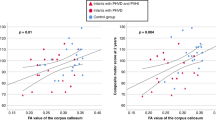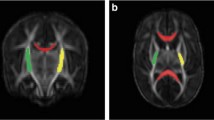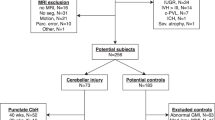Abstract
Introduction
Recent diffusion tensor imaging (DTI) studies have demonstrated that leakage of hemosiderin into cerebrospinal fluid (CSF), which is caused by high-grade intraventricular hemorrhage (IVH), can affect cerebellar development in preterm born infants. However, a direct effect of low-grade IVH on cerebellar development is unknown. Thus, we evaluated the cerebellar and cerebral white matter (WM) of preterm infants with low-grade IVH.
Methods
Using DTI tractography performed at term-equivalent age, we analyzed 42 infants who were born less than 30 weeks gestational age (GA) at birth (22 with low-grade IVH, 20 without). These infants were divided into two birth groups depending on GA, and we then compared the presence and absence of IVH which was diagnosed by cerebral ultrasound (CUS) within 10 days after birth or conventional magnetic resonance imaging (MRI) at term-equivalent age in each group. Fractional anisotropy (FA) and apparent diffusion coefficient (ADC) at the superior cerebellar peduncle (SCP), middle cerebellar peduncle (MCP), motor tract, and sensory tract were measured.
Results
In the SCP, preterm born infants with IVH had lower FA values compared with infants without IVH. In particular, younger preterm birth with IVH had lower FA values in the SCP and motor tract and higher ADC values in the MCP.
Conclusion
Low-grade IVH impaired cerebellar and cerebral WM, especially in the SCP. Moreover, younger preterm infants exhibited greater disruptions to cerebellar WM and the motor tract than infants of older preterm birth.



Similar content being viewed by others

References
Platt MJ, Cans C, Johnson A, Surman G, Topp M, Torrioli MG, Krageloh-Mann I (2007) Trends in cerebral palsy among infants of very low birthweight (<1500 g) or born prematurely (<32 weeks) in 16 European centres: a database study. Lancet 369(9555):43–50. doi:10.1016/s0140-6736(07)60030-0
Saigal S, Doyle LW (2008) An overview of mortality and sequelae of preterm birth from infancy to adulthood. Lancet 371(9608):261–269. doi:10.1016/S0140-6736(08)60136-1
Marlow N, Wolke D, Bracewell MA, Samara M (2005) Neurologic and developmental disability at six years of age after extremely preterm birth. N Engl J Med 352(1):9–19. doi:10.1056/NEJMoa041367
Marret S, Marchand-Martin L, Picaud JC, Hascoet JM, Arnaud C, Roze JC, Truffert P, Larroque B, Kaminski M, Ancel PY (2013) Brain injury in very preterm children and neurosensory and cognitive disabilities during childhood: the EPIPAGE cohort study. PLoS One 8(5):e62683. doi:10.1371/journal.pone.0062683
Volpe JJ (2008) Neurology of the newborn, 5th edn. Elsevier Health Sciences, Philadelphia
Ancel PY, Livinec F, Larroque B, Marret S, Arnaud C, Pierrat V, Dehan M, N'Guyen S, Escande B, Burguet A, Thiriez G, Picaud JC, Andre M, Breart G, Kaminski M (2006) Cerebral palsy among very preterm children in relation to gestational age and neonatal ultrasound abnormalities: the EPIPAGE cohort study. Pediatrics 117(3):828–835. doi:10.1542/peds. 2005-0091
Bassan H, Limperopoulos C, Visconti K, Mayer DL, Feldman HA, Avery L, Benson CB, Stewart J, Ringer SA, Soul JS, Volpe JJ, du Plessis AJ (2007) Neurodevelopmental outcome in survivors of periventricular hemorrhagic infarction. Pediatrics 120(4):785–792. doi:10.1542/peds. 2007-0211
Limperopoulos C, Soul JS, Haidar H, Huppi PS, Bassan H, Warfield SK, Robertson RL, Moore M, Akins P, Volpe JJ, du Plessis AJ (2005) Impaired trophic interactions between the cerebellum and the cerebrum among preterm infants. Pediatrics 116(4):844–850. doi:10.1542/peds. 2004-2282
Messerschmidt A, Brugger PC, Boltshauser E, Zoder G, Sterniste W, Birnbacher R, Prayer D (2005) Disruption of cerebellar development: potential complication of extreme prematurity. AJNR Am J Neuroradiol 26(7):1659–1667
Srinivasan L, Allsop J, Counsell SJ, Boardman JP, Edwards AD, Rutherford M (2006) Smaller cerebellar volumes in very preterm infants at term-equivalent age are associated with the presence of supratentorial lesions. AJNR Am J Neuroradiol 27(3):573–579
Parker J, Mitchell A, Kalpakidou A, Walshe M, Jung HY, Nosarti C, Santosh P, Rifkin L, Wyatt J, Murray RM, Allin M (2008) Cerebellar growth and behavioural & neuropsychological outcome in preterm adolescents. Brain 131(Pt 5):1344–1351. doi:10.1093/brain/awn062
Messerschmidt A, Fuiko R, Prayer D, Brugger PC, Boltshauser E, Zoder G, Sterniste W, Weber M, Birnbacher R (2008) Disrupted cerebellar development in preterm infants is associated with impaired neurodevelopmental outcome. Eur J Pediatr 167(10):1141–1147. doi:10.1007/s00431-007-0647-0
Volpe JJ (2009) Cerebellum of the premature infant: rapidly developing, vulnerable, clinically important. J Child Neurol 24(9):1085–1104. doi:10.1177/0883073809338067
Biran V, Verney C, Ferriero DM (2012) Perinatal cerebellar injury in human and animal models. Neurol Res Int 2012:858929. doi:10.1155/2012/858929
Neubauer AP, Voss W, Kattner E (2008) Outcome of extremely low birth weight survivors at school age: the influence of perinatal parameters on neurodevelopment. Eur J Pediatr 167(1):87–95. doi:10.1007/s00431-007-0435-x
Brouwer A, Groenendaal F, van Haastert IL, Rademaker K, Hanlo P, de Vries L (2008) Neurodevelopmental outcome of preterm infants with severe intraventricular hemorrhage and therapy for post-hemorrhagic ventricular dilatation. J Pediatr 152(5):648–654. doi:10.1016/j.jpeds.2007.10.005
Merhar SL, Tabangin ME, Meinzen-Derr J, Schibler KR (2012) Grade and laterality of intraventricular haemorrhage to predict 18-22 month neurodevelopmental outcomes in extremely low birthweight infants. Acta Paediatr 101(4):414–418. doi:10.1111/j.1651-2227.2011.02584.x
Klebermass-Schrehof K, Czaba C, Olischar M, Fuiko R, Waldhoer T, Rona Z, Pollak A, Weninger M (2012) Impact of low-grade intraventricular hemorrhage on long-term neurodevelopmental outcome in preterm infants. Childs Nerv Syst 28(12):2085–2092. doi:10.1007/s00381-012-1897-3
Patra K, Wilson-Costello D, Taylor HG, Mercuri-Minich N, Hack M (2006) Grades I-II intraventricular hemorrhage in extremely low birth weight infants: effects on neurodevelopment. J Pediatr 149(2):169–173. doi:10.1016/j.jpeds.2006.04.002
Tam EW, Miller SP, Studholme C, Chau V, Glidden D, Poskitt KJ, Ferriero DM, Barkovich AJ (2011) Differential effects of intraventricular hemorrhage and white matter injury on preterm cerebellar growth. J Pediatr 158(3):366–371. doi:10.1016/j.jpeds.2010.09.005
Tam EW, Ferriero DM, Xu D, Berman JI, Vigneron DB, Barkovich AJ, Miller SP (2009) Cerebellar development in the preterm neonate: effect of supratentorial brain injury. Pediatr Res 66(1):102–106. doi:10.1203/PDR.0b013e3181a1fb3d
Papile LA, Burstein J, Burstein R, Koffler H (1978) Incidence and evolution of subependymal and intraventricular hemorrhage: a study of infants with birth weights less than 1,500 gm. J Pediatr 92(4):529–534
Mori S, van Zijl PC (2002) Fiber tracking: principles and strategies—a technical review. NMR Biomed 15(7–8):468–480. doi:10.1002/nbm.781
Murakami A, Morimoto M, Yamada K, Kizu O, Nishimura A, Nishimura T, Sugimoto T (2008) Fiber-tracking techniques can predict the degree of neurologic impairment for periventricular leukomalacia. Pediatrics 122(3):500–506. doi:10.1542/peds. 2007-2816
Stieltjes B, Kaufmann WE, van Zijl PC, Fredericksen K, Pearlson GD, Solaiyappan M, Mori S (2001) Diffusion tensor imaging and axonal tracking in the human brainstem. NeuroImage 14(3):723–735. doi:10.1006/nimg.2001.0861
Koeppen AH, Michael SC, Li D, Chen Z, Cusack MJ, Gibson WM, Petrocine SV, Qian J (2008) The pathology of superficial siderosis of the central nervous system. Acta Neuropathol 116(4):371–382. doi:10.1007/s00401-008-0421-z
Thompson KJ, Shoham S, Connor JR (2001) Iron and neurodegenerative disorders. Brain Res Bull 55(2):155–164
Warner DS, Sheng H, Batinic-Haberle I (2004) Oxidants, antioxidants and the ischemic brain. J Exp Biol 207(Pt 18):3221–3231. doi:10.1242/jeb.01022
Fukumizu M, Takashima S, Becker LE (1995) Neonatal posthemorrhagic hydrocephalus: neuropathologic and immunohistochemical studies. Pediatr Neurol 13(3):230–234
Tam EW (2013) Potential mechanisms of cerebellar hypoplasia in prematurity. Neuroradiology 55(Suppl 2):41–46. doi:10.1007/s00234-013-1230-1
Hasegawa T, Yamada K, Morimoto M, Morioka S, Tozawa T, Isoda K, Murakami A, Chiyonobu T, Tokuda S, Nishimura A, Nishimura T, Hosoi H (2011) Development of corpus callosum in preterm infants is affected by the prematurity: in vivo assessment of diffusion tensor imaging at term-equivalent age. Pediatr Res 69(3):249–254. doi:10.1203/PDR.0b013e3182084e54
Pogribna U, Burson K, Lasky RE, Narayana PA, Evans PW, Parikh NA (2013) Role of diffusion tensor imaging as an independent predictor of cognitive and language development in extremely low-birth-weight infants. AJNR Am J Neuroradiol. doi:10.3174/ajnr.A3725
Volpe JJ (2009) Brain injury in premature infants: a complex amalgam of destructive and developmental disturbances. Lancet Neurol 8(1):110–124. doi:10.1016/S1474-4422(08)70294-1
Liu XB, Shen Y, Plane JM, Deng W (2013) Vulnerability of premyelinating oligodendrocytes to white-matter damage in neonatal brain injury. Neurosci Bull 29(2):229–238. doi:10.1007/s12264-013-1311-5
Morioka S, Morimoto M, Yamada K, Hasegawa T, Morita T, Moroto M, Isoda K, Chiyonobu T, Imamura T, Nishimura A, Morimoto A, Hosoi H (2013) Effects of chemotherapy on the brain in childhood: diffusion tensor imaging of subtle white matter damage. Neuroradiology 55(10):1251–1257. doi:10.1007/s00234-013-1245-7
Yeo SS, Choi BY, Chang CH, Jung YJ, Ahn SH, Son SM, Byun WM, Jang SH (2011) Periventricular white matter injury by primary intraventricular hemorrhage: a diffusion tensor imaging study. Eur Neurol 66(4):235–241. doi:10.1159/000330942
Miller SP, Vigneron DB, Henry RG, Bohland MA, Ceppi-Cozzio C, Hoffman C, Newton N, Partridge JC, Ferriero DM, Barkovich AJ (2002) Serial quantitative diffusion tensor MRI of the premature brain: development in newborns with and without injury. J Magn Reson Imaging 16(6):621–632. doi:10.1002/jmri.10205
Provenzale JM, Isaacson J, Chen S, Stinnett S, Liu C (2010) Correlation of apparent diffusion coefficient and fractional anisotropy values in the developing infant brain. AJR Am J Roentgenol 195(6):W456–W462. doi:10.2214/AJR.10.4886
Acknowledgments
We thank Ikumitsu Nagasaki, Department of Mathematics, Kyoto Prefectural University of Medicine, for advice on statistical analyses. This work was supported by the JSPS KAKENHI Grant Number 24591605.
Ethical standards and patient consent
We declare that all human studies have been approved by the Kyoto Prefectural University of Medicine Research Ethics Committee and have therefore been performed in accordance with the ethical standards laid down in the 1964 Declaration of Helsinki and its later amendments. We declare that all patients gave informed consent prior to inclusion in this study.
Conflict of interest
We declare that we have no conflict of interest.
Author information
Authors and Affiliations
Corresponding author
Rights and permissions
About this article
Cite this article
Morita, T., Morimoto, M., Yamada, K. et al. Low-grade intraventricular hemorrhage disrupts cerebellar white matter in preterm infants: evidence from diffusion tensor imaging. Neuroradiology 57, 507–514 (2015). https://doi.org/10.1007/s00234-015-1487-7
Received:
Accepted:
Published:
Issue Date:
DOI: https://doi.org/10.1007/s00234-015-1487-7



